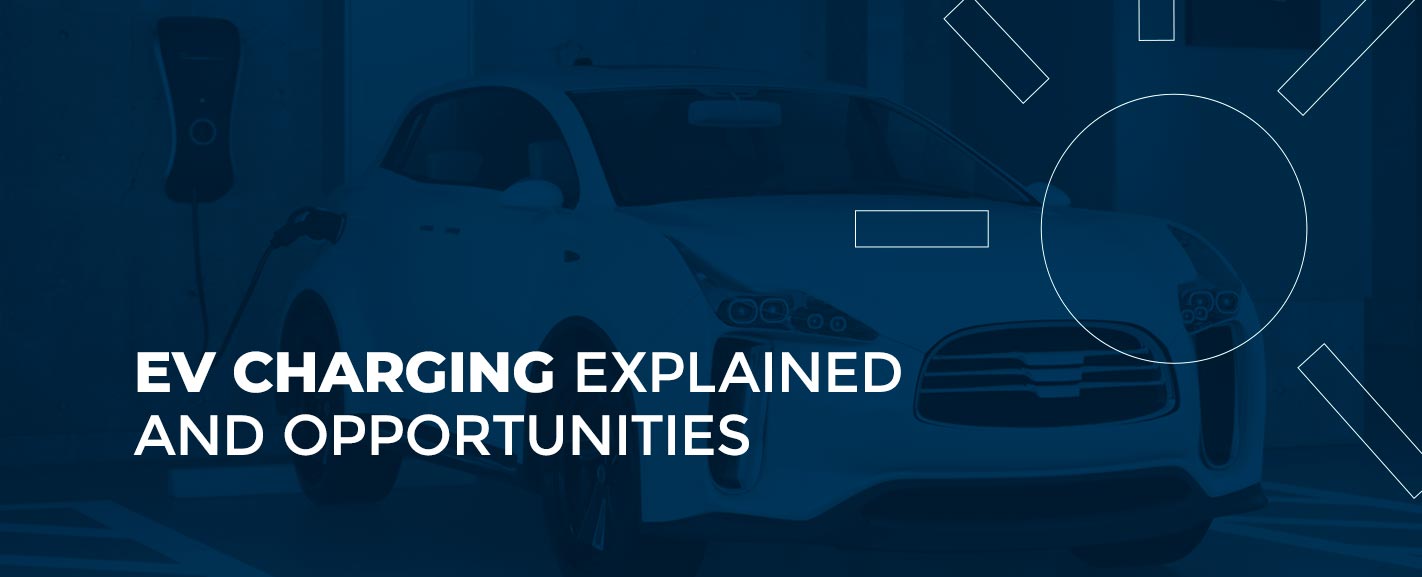
In 2010, six electric car models were available to the American public. By 2024, there will be more than 134 models available, and this number continues to rise. With many Americans looking for ways to combat rising gas prices and electric cars becoming more affordable, going electric is becoming a priority for many consumers.
Installing electric vehicle (EV) charging stations allows your business to reap numerous benefits and establish opportunities for value creation to put you ahead of the competition. Installing EV chargers can be a complicated undertaking. We will guide you through the entire process to ensure your EV charging adoption is successful.
What Is EV Charging?
An EV charger pulls an electrical current from the primary power grid and delivers this current to an electric vehicle through a connector or plug to power the motor.
Since non-hybrid varieties of EVs do not require gasoline, EV drivers have different fueling habits than drivers with gasoline-powered cars. Drivers of gasoline-powered vehicles fuel their tanks about once a week since they have to go out of their way to refuel, and the most time-efficient choice is to refuel when their tank is nearly empty.
EV charging is an entirely different process because electricity is more accessible. It can take five seconds to plug in a vehicle, and many charging stations are at people’s homes or in public places drivers regularly visit, such as the office or public parking garages.
Many EV drivers will charge their vehicles opportunistically, which is the process of plugging into stations when they are available nearby. While most drivers will plug in their car each time they arrive home to top off their battery, opportunistic drivers plug in anywhere at any time.
What Are EV Charging Stations?
An EV charging station uses electrical power to charge electric vehicles. EV owners can install a charging station at home or use public chargers often located in community parking lots, shopping centers and other high-traffic areas. A charging station can offer AC or DC power, where DC chargers convert AC power from the grid. If chargers offer an AC supply, it will need to be converted to DC before the vehicle’s battery can store it.
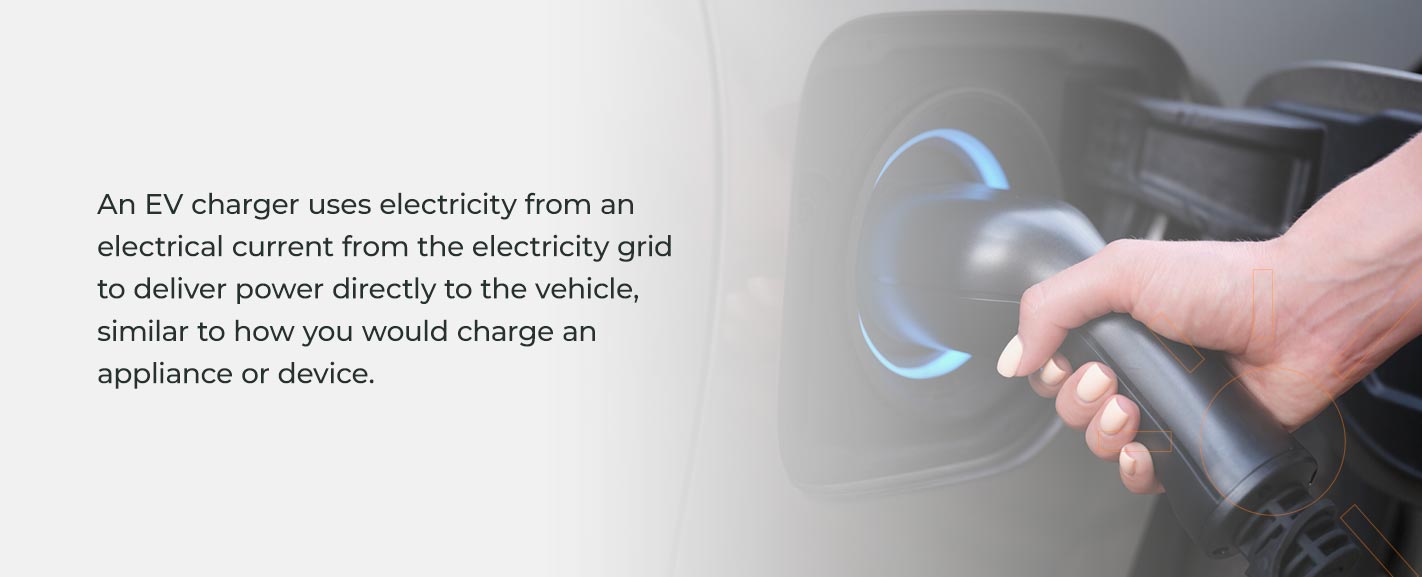
How do EV Charging Stations Work?
directly to the vehicle, similar to how you would charge an appliance or device. An electric vehicle then stores the electricity in a large battery pack to power the motor.
After a customer signs into the system, they will open the charging port and plug in their vehicle. While their car charges, the display will show how much electricity and money they have spent. They may unplug the charger when their car is fully charged and continue driving.
Types of Electric Vehicles
There are three main electric vehicles available:
Hybrid Electric Vehicle (HEV)
A hybrid electric vehicle (HEV) combines an internal combustion engine (ICE) with a battery pack and electric motor to lower fuel consumption. An HEV can utilize this combination by using an electric motor to power the car during situations in which the ICE by itself would be inefficient, such as accelerating after a stop. Hybrid vehicles also utilize the ICE unit during certain conditions such as driving on the highway.
HEVs primarily rely on gasoline power. HEV technology will automatically charge the battery through regenerative braking, which activates the motor, meaning that drivers do not have to monitor their charge or plug their car into a power outlet to charge. However, this battery is not enough to power the car entirely, so the driver will still have to put gas into the car. HEV’s cannot be plugged into an EV charger.
Plug-In Hybrid Electric Vehicle (PHEV)
Plug-in hybrid electric vehicles (PHEV) combine an ICE with a battery pack and electric motor. The electric system generally takes on more driving responsibility when the car is in motion, leading to larger battery packs and more powerful motors. Having these more powerful electric motors allows one to switch the ICE off completely and rely only on electricity to power the vehicle.
Driving a PHEV is comparable to driving a hybrid vehicle, as the battery will recharge automatically and the vehicle will switch between the electric power source and the ICE depending on driving needs. However, drivers can fuel their PHEV with gasoline or electricity, which means that the vehicle can operate on electricity for short distances if the battery is full or on gasoline, if the battery is depleted. PHEV’s can be plugged into an EV charger.
Battery Electric Vehicle (BEV)
A battery electric vehicle or an all-electric vehicle only runs on electricity and draws energy from onboard battery packs. BEVs do not contain an ICE and run completely on electricity for a larger battery capacity. Since a BEV requires additional technology to support the battery, BEVs often cost more than other electric vehicles. Drivers can charge BEVS on a home charging station or a public charging station and recoup energy through regenerative braking. BEV’s must be plugged into an EV charger.
Types of Chargers
A Level 1 charger is a 120-volt outlet an electric vehicle driver can plug into their home or garage. New PHEVs tend to have a Level 1 charger, and most PHEVs can reach a full charge overnight using a Level 1 charger. However, level 1 chargers are insufficient for the needs of most BEVs due to their slow charge since they only add about 4 miles of range per hour. Many EV drivers only use them as a backup.
Level 2 chargers are charging stations available in public spaces such as parking lots. While charging times will vary depending on the vehicle, they are generally faster than wall outlets and ideal for everyday use. Using a Level 2 charger, BEVs can fully recharge in four to 10 hours, while PHEVs can fully recharge in one to two hours.
A rapid charger, DC fast charger, and Tesla supercharger are all considered Level 3 chargers. A Level 3 charger allows the driver to recharge their EVs to 80% battery within an hour. A Level 3 charger is typically found at public charging stations and offers super fast charging, making it ideal for longer trips or whenever an EV owner needs a quick charge. PHEVs cannot use Level 3 charging.
Among these three levels of chargers, there are also connected AKA “smart” and non-connected chargers. A smart EV charger is a system where the electric vehicle and charging device share a data connection through an app and charging operator. A non-connected charger doesn’t offer cloud connectivity. Using smart charging systems allows charging station owners to charge for the electricity and monitor, manage, and restrict device use to optimize energy consumption.
What You Need to Know About EV Charging for Commercial Real Estate
As the number of electric vehicles on the road continues to grow, the demand for faster charging stations also continues to increase. Before installing a charging station at your business, it’s essential to consider the following factors:
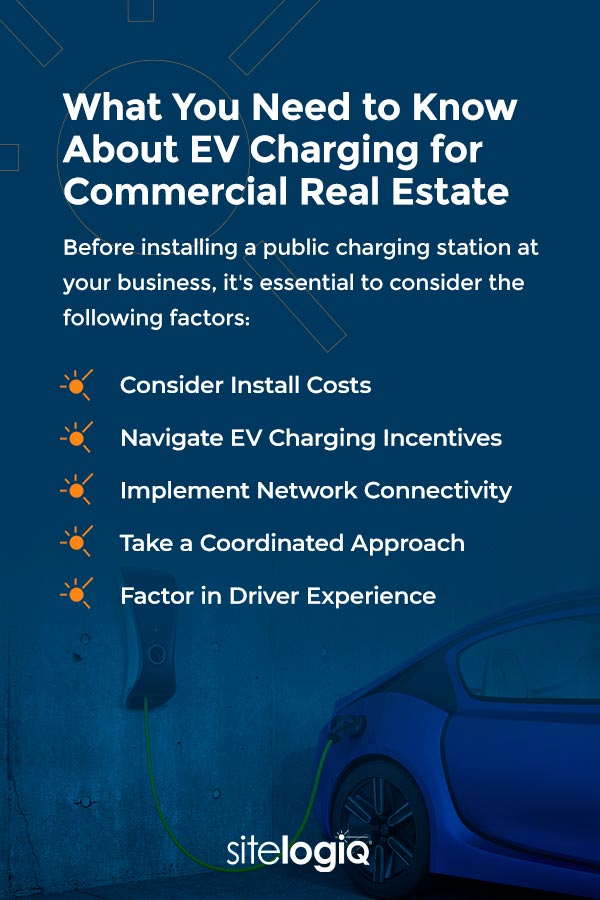
Consider Install Costs
The installation cost of your charging station will vary depending on the type and number of chargers and whether your business intends to install a Level 2 or a Level 3 charger. Some other installation costs to consider include:
- Number of chargers
- Charger manufacturer
- Charger level
- Labor
- Permits
- Taxes
- Location
- Landscaping and other lighting features
Turnkey energy solutions can help you manage the installation project from initial planning to construction management.
Navigate EV Charging Incentives
Tax credits are available for electric vehicle charging stations on the federal, state, and local levels. While most consumers know of the tax credit for individual electric vehicle purchases, many business owners may not know of similar electric vehicle supply equipment (EVSE) credits, such as the federal government credit that was recently renewed by the 2022 Inflation Reduction Act. These EVSE credits can mitigate the cost of expansion or essential infrastructure and make refueling accessible everywhere.
Incentives for installing commercial EV charging stations are still available from individual states and some power utility company programs, and your business can apply many of them toward the cost of equipment and installation. Since installation can be the most significant investment associated with installing an electric vehicle charger, having tax credits can result in substantial savings.
Depending on your state, you may also have the opportunity to apply for grants. View the National Conference of State Legislatures website to learn more about which tax credits and grants are available for your company.
Implement Network Connectivity
Integrating network connectivity creates a more sophisticated EV charging station system. Use a networked-connected system to:
- Monitor when and how often individuals utilize the EV chargers
- Manage energy use by reducing charging output during periods during peak hours or or when electricity rates are higher
- Charge visitors a fee to earn revenue with your EV charging stations
- Determine network status and troubleshoot concerns remotely and efficiently
Enable drivers to reserve a charging station, establishing organization for EV charger users
Take a Coordinated Approach
If you are installing charging stations at multiple locations, developing a coordinated approach is essential to ensure your charging stations offer a consistent experience. Some methods you can employ in your collaborative approach include:
- Establish a consistent playbook across communities
- Choose a single EV network provider with integrated hardware
- Include a standard service package with a single point of contact
Factor in Driver Experience
Creating a positive driver experience can be the difference between unsatisfied visitors and pleased customers that continue to return to your charging station. Some ways you can improve driver experience at your charging station include:
1. Reliability
Without a way to charge their card, drivers worry about being stranded. EV charging stations must be working at all times when drivers use them.
2. Visibility
Before any driver can use your charging station, they need to be able to find it. If you plan on building a public charging station, you need to ensure it is visible on online platforms, charging apps, and platforms such as Google and Apple Maps. Once your charging stations become visible online, you should also focus on your offline visibility with LED lighting and LED charging indicators to highlight which ports are currently available.
3. Safety
It is essential to ensure your charging stations are safe to protect users. Implementing LED lights on the tops and sides of your charging stations will make your charger more visible at night and increase safety. You can also employ cable management to improve driver interaction and prevent tripping hazards or drivers driving over the cables and damaging your charging station.
4. Interaction
When drivers arrive at your charging station, they want an easy-to-read and navigable interface. Since most EV chargers lack an interactive screen on which to begin the transaction and make payments, you need your EV charging stations to be part of a system with a functioning, easy-to-use smartphone app. Select a provider that has positive customer ratings on their app, as higher app ratings will reflect user satisfaction with the complete system.
5. Accessibility
Accessibility features such as wheelchair access are essential in advancing EV charging adoption, and they are also increasingly necessary to meet government regulations. Many states are also requiring all businesses to comply with requirements set by the Americans with Disabilities Act (ADA). Having accessible charging also allows all drivers to quickly and safely utilize your charging space and benefit your business.
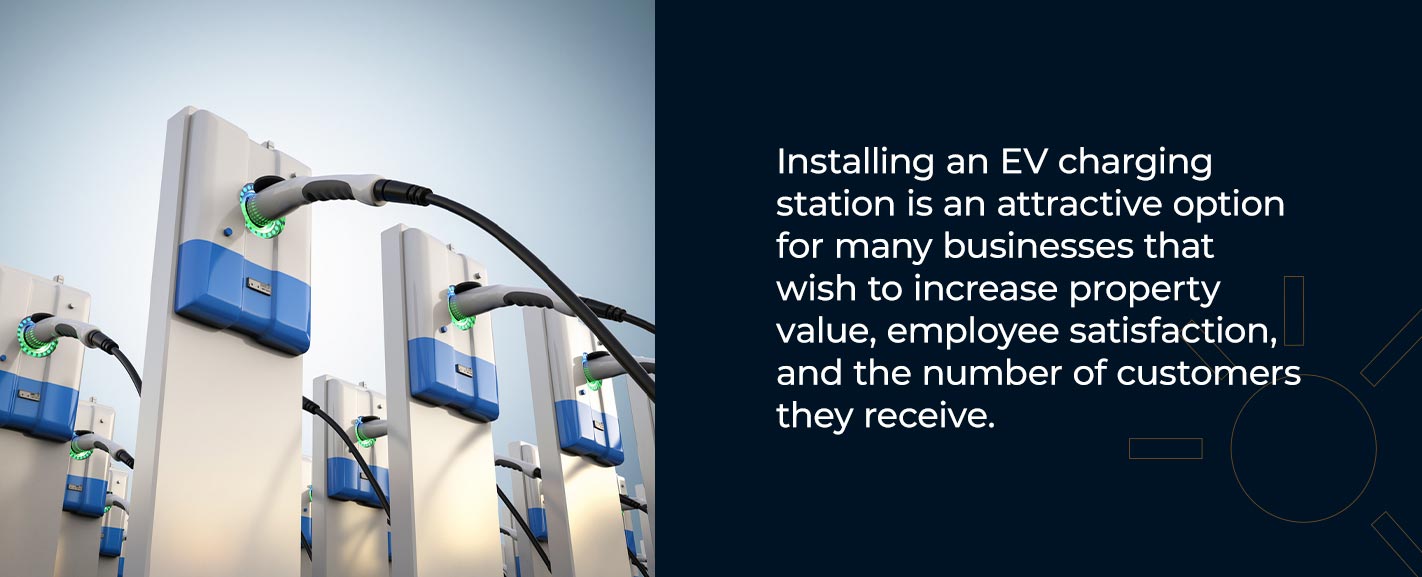
Is EV Charging right for my Commercial Property?
Electric vehicles are on pace to become the vehicle of choice for drivers. In fact, several of the worlds largest auto-makers are already planning to become all-electric brands within this decade. This means that EV chargers will be increasingly needed at the places people park their cars. Installing EV charging stations is an attractive option for many commercial real estate owners and operators that wish to increase property value, employee satisfaction, and the number of customers they receive. Ideal commercial properties for EV charging stations include:
Multifamily
Multifamily owners and operators have an early opportunity to encourage EV adoption and meet EV charger demands by installing EV chargers at their properties. According to Forbes, “Renters are demanding more eco-conscious options — their requests for EV charging stations will increase as demand for eco-friendly electric or plug-in hybrid vehicles increases.”
As electric vehicle adoption continues to increase, multifamily residents are also expecting to charge their electric vehicles where they live. In fact, Studies indicate that 85% of electric vehicle (EV) charging happens at home. Just like laundry machines, EV chargers will become a required amenity at most apartment communities in high EV adoption areas. Acting proactively to provide EV chargers at your multifamily properties is critical to resident retention and attraction, ultimately strengthening your position amongst the competition.
Shopping Centers
Many EV owners want parking options that allow them to charge their cars while they visit retail stores. Shopping centers that offer EV chargers will attract those consumers. Charging not only attracts customers but can also increase the amount of time and money spent in a store.
In fact, according to Fuels Institute, Electric Vehicle Council, EV Consumer Behavior report (June 2021), Battery electric vehicle (BEV) drivers expect to spend 30 minutes to one hour at the charger. Other studies/surveys suggest that these consumers would prefer activities to occupy their time while charging. Grocery store visits, dining, and shopping are the most preferred activities while waiting for their EVs to be charged.
Between attracting EV drivers, increasing foot traffic and dwell-time, shopping center owners are already reaping the benefits EV chargers bring to their properties.
Hotels
Charging is most common at places where people park their cars for long periods of time. Similarly to Multifamily, Hotel’s will be an important place that EV owners will rely on to charge up. Hotel owners are in a unique position when it comes to EV’s. With more drivers using their EV’s to travel and major car rental organizations such as Hertz already providing EV rentals to travelers, hotel owners must meet guest demands for EV chargers at their properties or risk losing the business to competitors who are providing EV chargers at their hotel sites. In order to remain competitive in the market, installing EV chargers at hotel sites is a must.
Contact SitelogIQ Today
The high demand for EV Charging Stations creates real value for occupants that gives you a competitive advantage. SitelogIQ offers the
- Helping you quickly and smartly make ESG progress
- Increase your portfolio value
- Meet real occupant demand for EV Charging stations
- Provide you with a competitive advantage
- Speed the transition to EVs
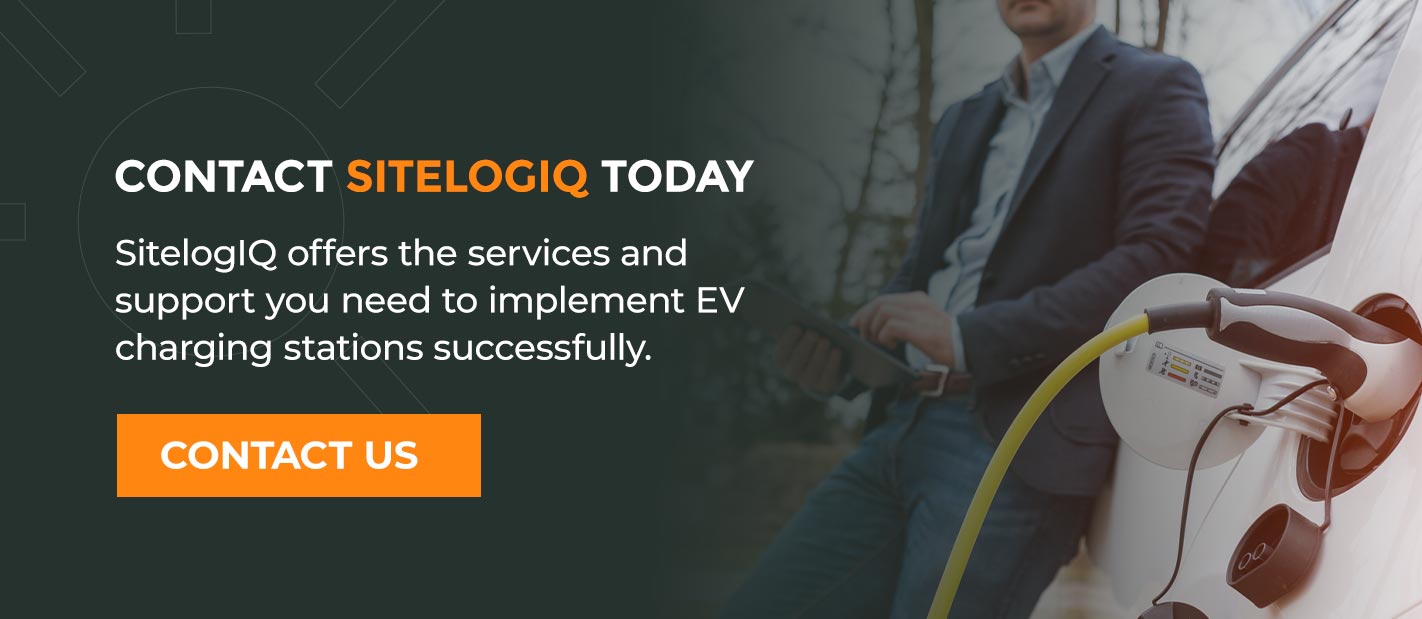
Contact our team today to take the first steps toward implementing commercial EV charging at your business.


